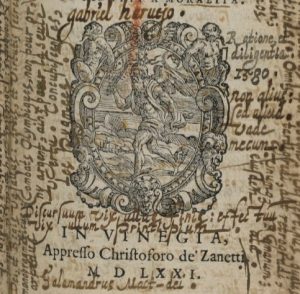Looking Back, Looking Forward
It’s been a busy few weeks here at AOR as we look to finalize the content of our website, and it’s hard to believe that our London symposium took place over a month ago!
 It was encouraging to see so many old and new faces in Senate House for our symposium, and to hear the ways that working in AOR has helped scholars investigate so many different aspects of Harvey and Dee’s books. Our presenters offered everything from close readings of individual annotations and drawings to sweeping, data-driven analyses that looked at the ways that Harvey and Dee employed language in their books. We were also able to give a sneak peek of the nearly-released viewer, which the attendees could use to explore the books under discussion.
It was encouraging to see so many old and new faces in Senate House for our symposium, and to hear the ways that working in AOR has helped scholars investigate so many different aspects of Harvey and Dee’s books. Our presenters offered everything from close readings of individual annotations and drawings to sweeping, data-driven analyses that looked at the ways that Harvey and Dee employed language in their books. We were also able to give a sneak peek of the nearly-released viewer, which the attendees could use to explore the books under discussion.
The mix of projects and questions really drove home a concept that we’ve been seeing in Dee and Harvey’s books (as well as in our own working methods as we transcribed and encoded them) – that this type of inquiry, whether in the sixteenth century or the twenty first, is at its best when it is collaborative. The data provided by the transcriptions allowed some of our presenters to dive deeply into questions that would have only been able to be addressed in a very limited sense in any given book, such as the use patterns of individual words. It was rewarding to see how the traditional, context-heavy studies of annotation in books reinforced each other, and made for a productive discussion of just what these things that we call annotations (or marginalia) actually are, and what they have to do with reading as we understand it today, or how Harvey and Dee understood it in their own time.
We’ve also been thinking about the ways that digital projects can and should change to keep up with their surroundings, and the fact that they’re never truly “done” in the sense of fixed, stable publications. As we concluded the symposium, Winston Tabb, Steve Ferguson, and Katie Birkwood led a panel on the development and management of digital projects like AOR in research libraries, and offered some insight on what “preservation” means in the digital age.
We also took the opportunity to record the thoughts and impressions of many of the archaeologists who have worked on the project since its inception (and in some cases before), a small teaser of which is above. They’ll be uploaded soon, so please watch this space. As we continue to look back over the AOR website and update the content, we’re well aware that we’re working in a perpetual present, and we’re happy to have these little time capsules back into the project phase available for you to see.
All in all, the symposium was a fitting milestone for the project, and a great sign of potential developments to come.
